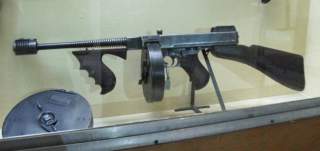Why the World Still Fears the Tommy Gun
Despite its relatively short service life, the Thompson is still recognized today as the iconic submachine gun.
America’s experience in the Great War, like that of many participants, made clear the need for a new type of infantry weapon for trench warfare: the submachine gun.
A shoulder-fired weapon, that emitted pistol ammunition, and was fully automatic, such a “trench broom” could be very useful in both offense and defense.
America’s answer, the Thompson submachine gun, arrived too late for World War I but had a starring role in World War II, where it equipped U.S. Marines, paratroopers, and other frontline troops in both Europe and the Pacific.
Brigadier General John T. Thompson a U.S. Army general officer in charge of small arms production in World War I. In 1917, Thompson saw the need for a “small machine gun”, a “trench broom” or “little machine gun” a soldier could hold in his hands, “fire from the hip and reload in the dark. “I want it right away,” Thompson told his subordinates and industry. “Now get to it. Expense is no object!“
The resulting gun, the M1921, was in many ways exactly what Thompson wanted. The M1921 had a shoulder stock and foregrip and fired the .45 ACP pistol cartridge (the same as used in the M1911 pistol). The M1921 had a maximum rate of fire of 800 rounds for a minute and fired from both 20 round box and 50 round drum magazines specially designed for the submachine gun. A specially designed muzzle compensator helped keep rounds on target during full auto fire. All of this firepower had a price, though: at 10 pounds 12 ounces and 33.75 inches long, the Thompson was heavier than the standard M1903 Springfield bolt-action infantry rifle, which weighed just 8 pounds but was 43 inches long.
The Thompson arrived on the scene too late for World War I, and during the interwar years, the weapon was continuously refined while being sold in small batches to police forces, U.S. Army, the U.S. Marine Corps, and even civilians. The first major order was from the U.S. Postal Service, which ordered 200 M1921s to provide security after a series of brutal mail train robberies. The weapon was redesignated the M1928, and one of the improvements was a finned barrel to assist in rapid cooling after fully automatic fire. Manufacturers included Colt’s Patent Firearms Manufacturing Corporation, Save Arms Company, and Auto-Ordnance Corporation.
The Thompson, also known as the “Tommy Gun”, was made in large numbers during World War II. Production spooled up shortly after the outbreak of the war, for while the U.S. was not yet a combatant many submachine guns were sold to Great Britain or lent as part of the Lease-Lend program. UK land forces had suffered huge losses in equipment after the evacuation at Dunkirk, and many units of the British Army had to completely re-equip. A year before Pearl Harbor the U.S. Army ordered approximately 20,000 M1928s; by February 1942 that number had zoomed to over half a million.
The need to manufacture previously unheard-of numbers of weapons lead to the Thompson being redesigned in a fashion more friendly to mass production.
The new M1 submachine gun’s internal operating system was simplified to accelerate production, and the rate of fire was slowed somewhat from 800 to 600 rounds a minute. In addition, the M1 was a quarter pound lighter than previous weapons and nearly two inches shorter.
Despite these changes, there was little difference in the weapon in terms of performance, and it could still unload an impressive amount of firepower in a matter of seconds. Like previous versions, one major disadvantage of the M1 was the effective range of its .45 ACP pistol caliber, which limited it to 200 yards.
The M1 was issued to all U.S. armed forces in World War II, including the Coast Guard. In addition to British forces they were also supplied to Commonwealth forces, Free French forces, Chinese forces, and thousands were delivered to the Soviet Union. Overall 1,387,134 Thompsons were built during the war by U.S. armories, after which they were sent to the four corners of the globe in the fight against fascism. Towards the end of the war production was slowed in favor of the simpler, cheaper M3 submachine gun.
The Thompson submachine gun saw further use in Korea and Vietnam. But by that time the weapon’s design was considered a relic. The Thompson’s internal complexity, weight, and heavy recoil ensured its withdraw, en masse, from armies around the world.
The AK-47, by contrast, was lighter, more easily controllable.
And it had a greater effective range. But despite its relatively short service life, the Thompson is still recognized today as the iconic submachine gun.
Kyle Mizokami is a defense and national-security writer based in San Francisco who has appeared in the Diplomat, Foreign Policy, War is Boring and the Daily Beast. In 2009 he co-founded the defense and security blog Japan Security Watch. You can follow him on Twitter: @KyleMizokami.
Image: Wikimedia Commons.

